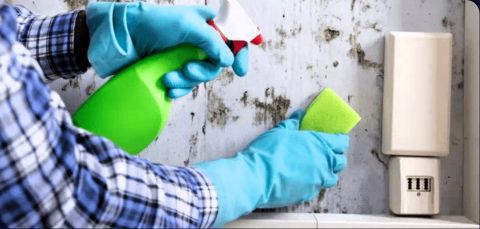Your home
Damp & mould
All homes are at risk of condensation, especially during the colder winter months. While small amounts of condensation are normal, excess moisture can lead to mould growth, which may affect both your health and the condition of your home.

Report Damp & Mould by Calling 020 8607 7777
You can report damp and mould directly to our contractor Ecosafe by giving us a call on 020 8607 7777. Select 1 for Repairs, then 1 again to report damp and mould to Ecosafe.
At Karibu, we take our responsibility seriously to provide you with a safe and healthy living environment. That’s why we’re committed to offering practical advice and explaining the different ways you can report damp and mould to us if you notice a problem.
Karibu’s Commitment Under Awaab’s Law
From 27 October 2025, Awaab's Law will come into effect, introducing legally binding timeframes for social landlords to investigate and resolve hazards such as damp and mould.
Karibu fully supports the principles of Awaab's Law, and we are committed to acting swiftly and responsibly when damp and mould are reported to us. Our commitments to customers are:
- Investigate emergency hazards within 24 hours of being reported to Karibu or our appointed contractors, and take immediate action to make your home safe.
- Offer alternative accommodation where necessary if a property cannot be made safe within the required timeframe.
- Respond to significant damp and mould concerns within 10 working days, either through a visit from our contractor or a Karibu Surveyor. We will provide clear updates, and within those 10 working days, we will begin the repairs.
We believe everyone deserves a home that supports their health and wellbeing. If you notice damp or mould in your home, please report it to us immediately so we can take action.
Emergency Vs Significant Hazards
Under Awaab’s Law, social landlords in England must respond to housing hazards within strict timeframes, based on whether the issue is classified as Emergency or Significant. Here's a breakdown of the emergency vs significant criteria:
Emergency Hazards
Definition: Hazards that pose an imminent and significant risk of harm to health or safety. These require immediate action.
Examples:
- Extensive black mould in a child’s bedroom or throughout the property.
- Severe damp causing structural instability
- Mould causing acute respiratory issues
Response Requirements:
- Within 24 hours: Investigate and make the property safe or offer alternative accommodation
- Within 3 working days: Provide a written summary of the investigation and actions taken
Significant Hazards
Definition: Hazards that pose a serious health risk but are not immediately life-threatening. These still require prompt attention.
Examples:
- Damp and mould not causing immediate harm but affecting health over time
- Excessive draughts coming into a property through windows which as a result has caused early signs of mould to appear around the surrounding areas.
Response Requirements:
- Within 10 working days: Investigate the hazard
- Within 5 working days after investigation: Begin repairs
Triage Questions Karibu and our Contractors will ask you
When residents or their representatives report damp or mould to Karibu or our contractors, we assess each situation on a case-by-case basis. We recognise that every case is unique, and therefore we follow a structured triage process to ensure appropriate action is taken.
As part of this process, we ask a series of standardised questions relating to:
- Resident vulnerabilities
- Health concerns
- Details about the damp or mould issue
We may also request photos to help us determine the most suitable category for the case. This enables us to prioritise effectively and respond appropriately.
We believe in working collaboratively with our contractors, so our triage questions and service standards are aligned across all parties. This ensures consistency, fairness, and a high-quality response for every resident.
Preventative Tips for Damp & Mould

Ventilation & Airflow
- Open windows regularly to allow fresh air to circulate
- Use extractor fans in kitchens and bathrooms
- Avoid blocking air vents or trickle vents on windows

Moisture Control
- Dry clothes outdoors or in well-ventilated areas
- Use a dehumidifier in rooms prone to damp
- Wipe down condensation from windows and walls daily

Property Maintenance
- Report leaks or plumbing issues promptly to our Contractors Chigwell, MNM or to Karibu
- Regularly clean your kitchen and bathroom extractor fans to maximise their efficiency. This is your responsibility as a Karibu resident. If your extractor fan is not working, please report it Chigwell, MNM or to Karibu
- When you redecorate your property, use a good quality anti-fungicidal paint to help prevent mould appearing again

Temperature Regulation
- Maintain a consistent indoor temperature. It is better to heat your home gently throughout the day than to heat it for a brief period
- Use heating to reduce humidity, especially in colder months
- Thick curtains above radiators will stop heat from escaping
- Keep curtains/blinds open on sunny days to help warm rooms
- Don’t trap heat - ensure large furniture is kept away from radiators as it prevents heat from circulating

Cleaning & Monitoring
- Regularly clean areas prone to mould (e.g., bathroom tiles, window sills)
- Use mould-resistant paint or sealant when decorating your property
- Inspect hidden areas like behind furniture or inside cupboards and clean these easily forgotten areas
- If you notice after cleaning mould away and it re-appears regularly please report it to our specialist contractor Ecosafe on 020 8607 7777.
Escalating your concerns
If you have informed us of a damp and mould problem and we have not resolved the issue to your satisfaction, please escalate the issue using our complaints process.
You can find the full complaints policy and procedure on this page under Downloads section or on our Policy Library page.
